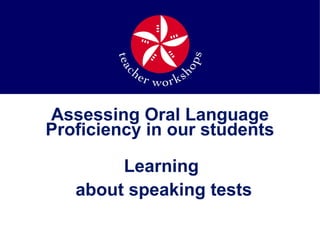
Assessingspeaking
- 1. Assessing Oral Language Proficiency in our students Learning about speaking tests
- 3. What’s on tap? What are the principles of good test design? Practice making test rubrics and assessing. Learn how to deliver and design a “retelling” speaking test AND a level placement test.
- 4. The Objective of Education
- 5. What do you believe….? We give tests so that …………………….. Tests provide teachers with …………………….. When testing in my class, I usually …………………….. Tests help students …………………….. A good speaking test should …………………….. All tests must …………………….. My opinion on tests is …………………….. An example of one kind of test is …………………….. 1
- 6. What does speaking consist of? Fl uen cy Vo c ab ul a ry iation What should Pr onunc we assess? p. o m /C ls kil Gr s ing en am Li st ma r
- 7. The Alphabet Soup of Assessment
- 8. Background: The Purpose of Tests Andrew Finch, Kyungpook Nat. Univ. of Education , Daegu, S. Korea
- 9. Complete the Following….. The purpose of testing is…. Tests can easily become …. Classroom based tests should ……… Also, they should ……….
- 10. Complete the Following….. The purpose of testing is…. To give information to the students and teachers (also parents!)
- 11. Complete the Following….. Tests can easily become …. Normative and Comparative. (but should be Criterion based and about what the student CAN do)
- 12. Complete the following Classroom based tests should ……… - Non – threatening environment - Focus on “real situations” and the process of learning.
- 13. Complete the Following….. Also, they should ………. Provide big picture. Emphasize thinking skills and collaboration. provide information and be about the learning.
- 14. THE GOLDEN RULE! Test what the student CAN do NOT What the student can’t!
- 15. Basics 1 – Making a rubric What is a rubric? "a scoring tool that lists the criteria for a piece of work or 'what counts.' " -- Heidi Goodrich 2-3
- 16. Fill in the rubric with descriptors Fluency Limited some good Well Developed unclear Parts clear Mostly clear Very clear Pronunciation Vocabulary limited adequate sound extensive Effort poor fair Good excellent
- 17. Assessing through an Interview Students know the questions and have practiced. Design the rubric. Select 4 questions to ask a student. Score the student based on their response.
- 18. Oral Assessment using retelling Retelling is a powerful way to fully assess a student’s ability to produce language. It shows with validity that a student understands the language used and most importantly, can use it. ______________________________________ 1. List the main ideas of the story. 2. Design a rubric or storytelling checklist. 3. Ask the student(s) to retell the story. 4. Check all ideas that the student successfully retells/relates. 5. Total the score.
- 19. Checklist Major Ideas: Heungbu / Nolbu 1 2 3 Two brothers, one good , one bad. Heungbu asks for food. Nolbu refuses. A swallow comes. Heungbu helps. Gets a seed. 3 pumpkins grow. Treasure comes out. Nolbu is jealous. Does the same. Monsters come out. Heungbu helps Nolbu. Nolbu changes. They live happily. Score
- 20. Oral Assessment using “sequencing” – HOW TO……. Explaining “how to” do something is an excellent way to assess student speaking ability. ________________________________ 1. List the main steps. Teach / practice. 2. Design a checklist. 3. Ask the student(s) to explain “how to...” 4. Check all steps that the student successfully retells/relates. 5. Total the score. 4
- 21. Checklist Steps: How to make a P&J sandwich 1 2 3 Get two slices of bread. Put peanut butter on one. Put jelly on top of the peanut butter. Cut the sandwich in half. Eat the sandwich!
- 22. Beware of “narrow” testing
- 23. Be Careful! Assure all students understand the criteria of assessment (the rubric) Did you teach enough, the required Pre Test content? Check for “Silent Period” Provide a proper environment / warm up. During Testing Test what you taught! Give students specific feedback After Testing allow for a retake. Praise! Flood & Lapp, 1992
- 24. Placement Testing Key Vocabulary A great Picture Character 1: Character 2: Questions in increasing difficulty Vocabulary Rank
- 25. Websites to help test speaking Teacher Evaluation
- 27. “one teaches, two learn.” ddeubel@gmail.com http://eflclassroom.ning.com
